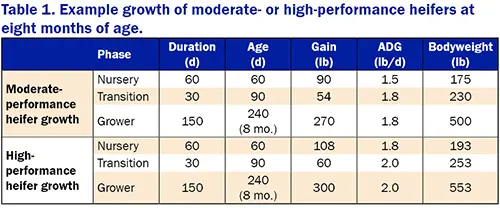
Growing Heifers to Reach Puberty Earlier has Benefits

 By Pat Hoffman, Vita Plus dairy technical specialist, and Dr. Noah Litherland, Vita Plus dairy youngstock technical specialist
By Pat Hoffman, Vita Plus dairy technical specialist, and Dr. Noah Litherland, Vita Plus dairy youngstock technical specialistPuberty in dairy heifers can be defined as a measurable increase in blood progesterone with the presence of a corpus luteum (CL) on an ovary, and heifers begin active cycling. Dairy heifers reach puberty at a defined stage of maturity (45 to 50 percent of mature size) rather than a certain age.
The onset of puberty is not an acute event. Rather it is a chronic event and occurs over a few months as the heifer matures and reproductive hormone concentrations reach a threshold for estrus cycle initiation.
Mature cow size is defined as the weight of third-lactation cows. Holstein heifers should reach puberty by 600 to 700 pounds in herds with 1,400-pound mature cows or 700 to 800 pounds in herds with 1,600-pound mature cows.
Several factors impact age of puberty, including breed, genetic maturity, nutrition, management and health. Stressors, such as thermal stress, impact the hormonal cascade that controls heifer development. Many hormones influenced by nutrition also carry out important roles in reproduction.
Benefits of increased heifer growth rates
Increased heifer growth rates do not mean a farm will produce larger cows. Rather, they mean heifers will get to a productive size more quickly and efficiently, improving profitability for farmers and heifer growers. Although heifers can be fed and managed to reach maturity earlier, heifers should still be bred at 55 percent of mature size and calve in no earlier than 22 months of age.
Increasing efficiency to calve in more heifers at the targeted age range minimizes excessive days on feed. It also has benefits related to the increased number of estrus cycles heifers experience. Researchers reported up to a 21-percent increase in heifer fertility from pubertal estrus to the third estrus. Increasing the number of full estrus cycles before breeding also has an impact on mammary gland parenchyma tissue development. This is a slow and highly coordinated process.
Let’s look at a simple example demonstrating how growth rate in all three phases impacts the age heifers reach 550 pounds. In the table below, the high-performance heifer grew to 550 pounds in eight months, while the moderate-performance heifer reached 500 pounds at the same age. The high-performance heifer is a whole month of growth ahead of the moderate-growth heifer and will likely have advantages of an extra estrus cycle before breeding time, greater mammary gland development at breeding, and greater reproductive efficiency.
In the nursery phase…
Feed calves for a balanced nutrient supply from milk and starter grain, and maintain calf growth rate through the transition period. A reasonable goal for Holstein heifers is 190 pounds at 60 days or an average daily gain of 1.8 pounds per day.
Starter grain intake is critical for establishing a fast start to gastrointestinal tract maturity and, therefore, steady growth through weaning and transition. A reasonable goal for Holstein heifers is an average starter intake of 1.6 to 2 pounds per day.
In the transition phase…
The goal in the transition phase is to maintain momentum from the nursery phase. Adequate calf size, a functioning and healthy rumen, a low-stress environment, and adequate access to feed and water all impact success in the transition phase.
During this time, maintain feed intake and keep lungs healthy. Make sure feedbunks are designed to allow easy access to grain and that the feed’s starch and fiber concentrations are in balance.
In the grower phase…
During the grower phase, calves are sensitive to environmental and nutritional inconsistency. Some research has shed light onto the impacts of challenging environments and errors in nutrition on these heifers. Strive to maintain stocking density of heifer pens at or below 100 percent to minimize antagonistic social behaviors by dominant heifers.
Feeding growing heifers corn contaminated with mycotoxins delayed puberty compared with heifers fed uncontaminated corn. Parasite infections during heifer development impaired normal growth and delayed onset of puberty through altered hormone profiles.
Summary
Work with your nutritionist, veterinarian, and farm records to better understand the development of your heifers and consider how earlier puberty may affect your herd’s performance. Take a close look at how age at puberty impacts age at breeding, age at calving, feed costs, number of nonproductive days, reproductive efficiency and first-lactation milk yield. You might be surprised by the opportunities you find.
This article was originally written for the August 25, 2017 issue of Progressive Dairyman. Click here for the full article.
| Category: |
Business and economics Calf and heifer nutrition Starting Strong - Calf Care Transition and reproduction |


